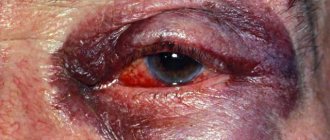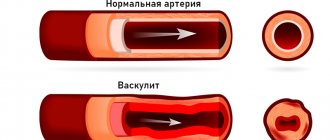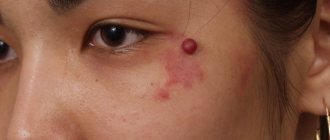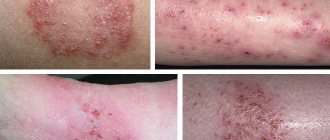Description of the disease
Chorioretinitis of the eye is a chronic vision disorder in which the back of the eye becomes inflamed, eventually involving the retina and choroid.
It is worth noting that the disease is something other than a symbiosis of signs of two pathologies - choroiditis and retinitis. The retina of the eye is nourished by the choriocapillary vessels, so even the slightest change in these vessels inevitably leads to damage to the retina, but this is not a death sentence. But why blood vessels burst in the eyes and what can be done about such a problem is indicated in the article at the link.
There are a huge number of variations in the course of chorioretinitis; the degree of damage is determined precisely by the form of the disease. For example, toxoplasmosis chorioretinitis is characterized by damage to the central nervous system; if a person is diagnosed with a syphilitic form of pathology, then the formation of foci of alternating atrophy and fibrosis in the fundus is likely.
In the video - chorioretinitis of the eye:
The tuberculous form of chorioretinitis is characterized by the fact that during diagnosis in the fundus of the eye it is possible, without the slightest shadow of doubt, to detect special formations called disseminated tubercles. But what are the symptoms of eye tuberculosis and what can be done about such a problem is indicated here.
Diagnostics
To clarify chorioretinitis, several diagnostic methods are used:
- vision assessment (reduced, not corrected);
- ophthalmoscopy;
- computer perimetry (reduced contrast sensitivity of the retina, dark spots);
- Ultrasound diagnostics;
- biomicroscopy (vitreous disorders);
- refractometry;
- fluorescein angiography (vascular assessment);
- electroretinography;
- Optical coregent tomography (retinal check).
Photo of an inflamed eyeball
In diagnosing chorioretinitis, it is also important to establish the causes of its occurrence. To do this:
- Analysis of urine;
- blood tests (general, RW, various infections);
- fluorography of the chest.
Depending on the characteristics of the disease, sometimes they consult with other specialists, for example, an ENT doctor, a venereologist, an immunologist.
Symptoms
The symptoms of chorioretinitis of the eye can be either purely neutral, if it is an inflammatory process localized in the peripheral zone, or pronounced in nature - if the inflammation affects the central area, which is why the treatment of chorioretinitis involves rather eclectic methods.
With chorioretinitis of the eye, the patient experiences a decrease in visual acuity; when watching TV, staying awake, or doing any other activity, “flies” begin to fly in front of the eyes.
Interesting information on the topic! Find out why the lower eyelid of your left eye is twitching.
In addition, a dark blot appears on the affected eye organ, which constantly falls under the gaze of others; among other things, a patient with chorioretinitis develops a critical idiosyncrasy of bright light rays (but what drops for dry eyes are best to use are outlined here), vision begins to rapidly decline , because of which a person begins to see surrounding objects in a distorted form. But this information will help you understand what tunnel vision looks like in men, and what can be done about such a problem.
Classification
The classification of chorioretinitis according to the forms and types of its development should be considered:
- Based on the area of damage, they are divided into types:
- Central – macular region.
- Peripapillary – optic disc.
- Equatorial - equator.
- Peripheral - the border of the dentate line.
- The types are divided according to the number of foci:
- Focal - one area is inflamed.
- Multifocal disseminated - inflammation of several areas.
- Diffuse - several foci merging.
- According to the duration of the flow, the following forms are distinguished:
- Acute – up to 3 months.
- Chronic – more than 3 months.
- According to pathogens, chorioretinitis is infectious:
- Toxoplasmosis is congenital, transmitted from the mother. It is chronic. Affects the central nervous system and other organs besides the eyes.
- Syphilitic - alternating places with fibrosis and atrophy.
- Tuberculous - develops only in the presence of tuberculosis in the lungs. Disseminated tubercles and chorioretinal scars are formed.
- Purulent - is the result of immunodeficiency. Dangerous due to the possibility of exudate spreading to neighboring parts of the eye.
- Immunodeficiency (in HIV-infected people).
- Infectious-allergic.
- Non-infectious-allergic.
- Infectious.
- Post-traumatic, etc.
go to top
Surgery
If all your attempts based on conservative treatment methods have been in vain, it’s time to see a doctor so that he can refer you for surgery, which is most often done for retinal detachment.
The laser correction method is based on blocking defects in the basal plate; after laser coagulation, the patient feels swelling, which may not go away for up to 10 days, and in order for him to sleep as quickly as possible, retrobulbar injections of a corticosteroid will be required.
Interesting information on the topic! Find out why retrobulbar neuritis is dangerous and what treatment methods are available.
Symptoms of pathology
IN
At the very beginning of its development, serous chorioretinitis is accompanied by the appearance of fog before the eyes. After some time, when examining objects, a dark spot appears before the patient’s eyes. Sometimes light perception may change, and the initial stage of the pathology is characterized by the appearance of the following signs:
- Severe or slight decrease in vision.
- Blurred picture before my eyes.
- The presence of dark spots, flashes and haze before the eyes.
- Problems with orientation in space and especially at night.
- Distortion of objects before the eyes.
If such symptoms occur, you should consult an ophthalmologist as soon as possible.
In some cases, the inflammatory process in the organ of vision occurs without the appearance of characteristic signs and nothing bothers the patient. It is possible to diagnose any disorders in such a situation only after a thorough examination of the patient.
Chorioretinitis may be accompanied by scarring, and the presence of white lesions indicates the presence of inflammation. In the acute stage of the disease, identifying such changes is quite problematic, and their boundaries are unclear. When the inflammatory process is activated, dangerous consequences such as tissue thickening, retinal detachment and subretinal hemorrhage may develop.
Folk remedies
- Note! For a speedy recovery, the body needs vitamins - this is rule No. 1, the body of a patient with chorioretinitis should not suffer from a deficiency of ascorbic, folic acids, as well as vitamins PP, B6.
- Golden recipe! We got it as a tribute from our great-grandmothers, this infusion of hazel bark is a miraculous remedy that dilates blood vessels. To prepare it, take 10 grams of dried hazel bark, place it in a container and pour hot boiling water over it, infuse it and take 10 grams daily.
- Traditional medicine recipes can become a lifeline in the treatment of ocular chorioretinitis ; they are good because they can have a positive effect on the speed of recovery, of course, if they are used wisely, for example, in combination with pharmacological drugs.
Recipe No. 1
Healing infusion of valerian. To prepare this wonderful medicinal product, you will need to boil the roots of this plant in water for half an hour (for 250 ml of water - 1 tablespoon of roots). To achieve positive results in treatment, it is recommended to take 1 tablespoon 5 times a day.
Symptoms of chorioretinitis
One of the symptoms of the disease is vision impairment
At the beginning of its development, serous chorioretinitis is characterized primarily by blurred vision, and a few days later a dark spot appears in front of the eye. A significant change in color sensation may also be observed. The initial stage of chorioretinitis is characterized by the following symptoms:
decreased vision (this is especially evident with purulent chorioretinitis) - the appearance of flashes before the eyes - distortion of vision (metamorphopsia) - “night blindness” (poor vision at dusk) - "floaters" in front of the eyes - clouding of the retina - pain in the eyes - increased light sensitivity
The anterior part of the eyeball, as a rule, is not affected by this disease. When inflammation occurs in the posterior part of the eyeball, one lesion or multiple lesions may develop. Such focal chorioretinitis can be located in the center of the posterior compartment or on the periphery (peripheral chorioretinitis). The disease can also affect other areas (peripapillary and equatorial chorioretinitis). It is the location and number of such foci that influences the symptoms of this disease.
It should not be forgotten that chorioretinitis must first be differentiated from choroidal tumors and, in the case of a central location of the lesion, from macular degeneration. Any of the above symptoms indicates a rather serious disease of the organ of vision, so if they occur, it is necessary to urgently contact an ophthalmologist.
Prevention
Since this disease usually appears as a result of exposure to various infections, toxins and injuries on the body, in order to prevent the development of the problem, it is necessary to try to prevent injury to the eye area and promptly treat emerging infections and allergic reactions. Any neglected negative state of the body can develop, leading to the appearance of this problem.
What is conjunctival chemosis?
Everything about Tobrazon eye drops with instructions for use is written in this article.
Tetracycline eye ointment https://eyesdocs.ru/medicinaoperacii/lekarstva/instrukciya-po-primeneniyu-glaznoj-mazi-tetraciklin.html
Causes of the disease
Among the factors that can provoke pathology, the main ones are the following:
- penetration of infections into the organs of vision ;
- the presence of herpes virus and HIV in the body;
- autoimmune pathologies;
- eye injuries (regardless of their origin);
- complications resulting from myopia ;
- allergic reactions;
- exposure to radioactive radiation .
Pathology can also occur as one of the complications of influenza.
Treatment
The main methods of treating chorioretinitis are the following procedures:
- Immunotherapy with immunosuppressants (immunostimulants can be used as an alternative).
- Laser coagulation of the retina.
- Hemodesis (detoxification procedures).
- Injections directly into the eyeball .
- A course of taking anti-inflammatory drugs .
- Antibacterial drugs that should stop the root cause of the disease (antibiotics of the penicillin group are mainly used for this).
- Antiviral drugs.
- Treatment with physiotherapeutic methods (the most effective is electrophoresis ).
Note! The use of traditional medicine methods for chorioretinitis is recognized as ineffective and is unacceptable either as the main treatment or as a means of helping to relieve symptoms.
Moreover, such methods can only aggravate the situation, provoking the development of inflammatory processes.












